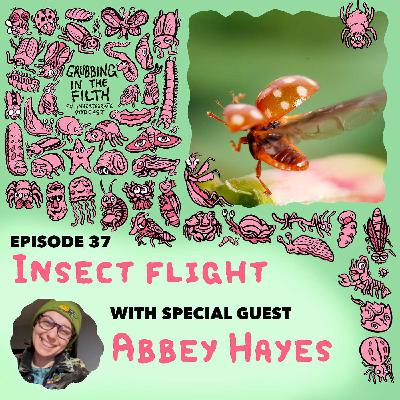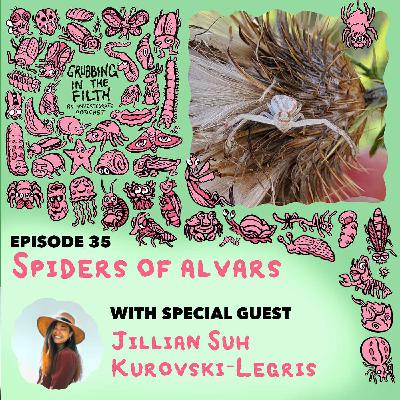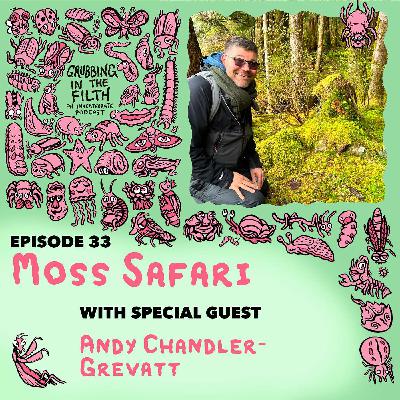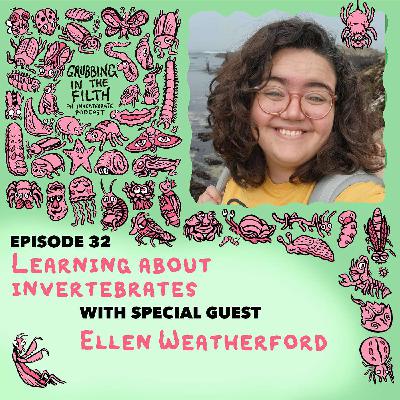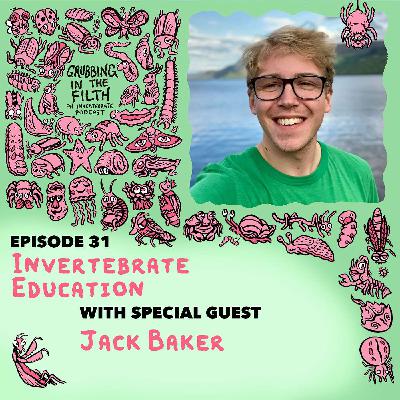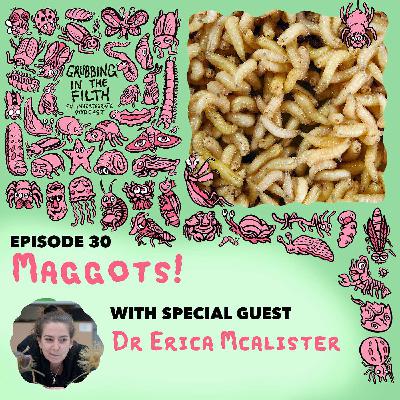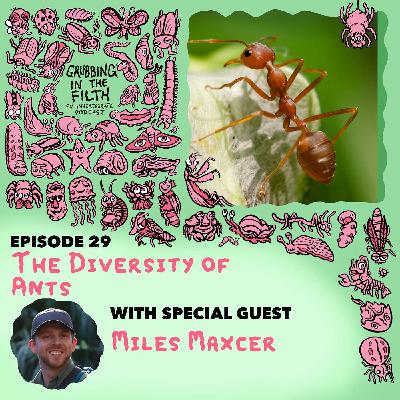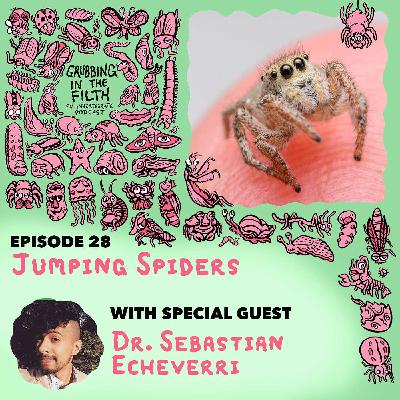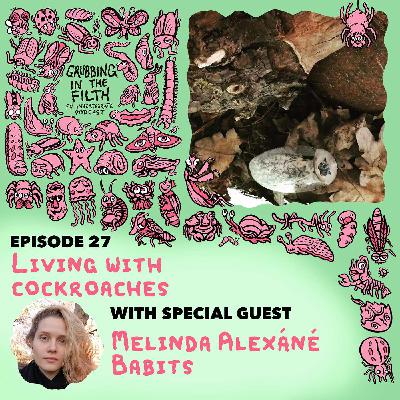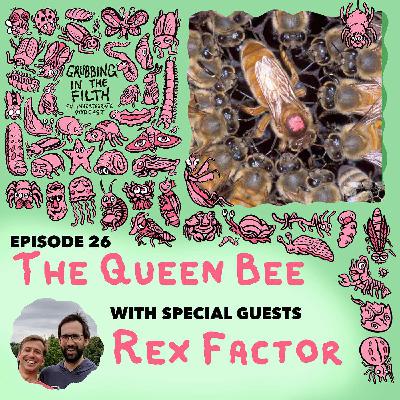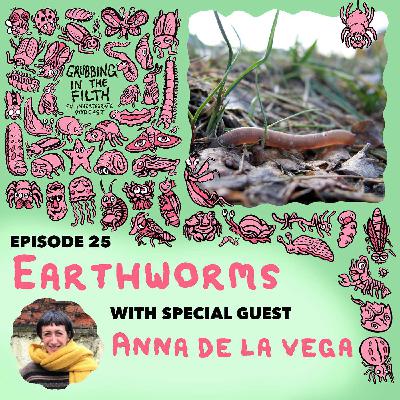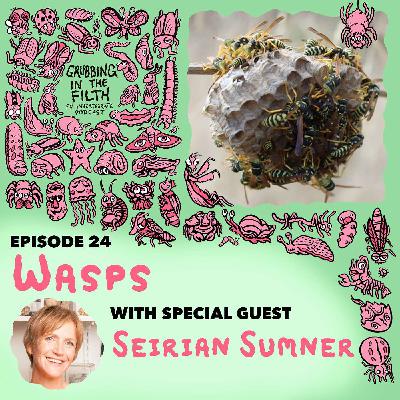Discover Grubbing In The Filth: An Invertebrate Podcast
Grubbing In The Filth: An Invertebrate Podcast

Grubbing In The Filth: An Invertebrate Podcast
Author: Grubbing In The Filth
Subscribed: 40Played: 589Subscribe
Share
© 2024 Grubbing In The Filth: An Invertebrate Podcast
Description
If it lacks a backbone, we're interested. In this podcast, we're exploring the world of invertebrates, discovering the amazing lives they lead, and thinking carefully about our relationhips with these much-maligned creatures. With the help of experts, we are lifting stones, peering into the water and grubbing in the filth.
38 Episodes
Reverse
Today, its time for a lofty subject, as it were: Tom is joined by Abbey Hayes to discuss the original (and best?) form of flight: insect flight. We’ll be delving into millenia-long developments, and considering wild unknowns. We'll speculate, exploring genetics and molecular tools, as well as settling big questions like 'who's got the best wings?'. Join us, for a thorough and exciting look at this incredible subject.
Alert! Alert! This is a time sensitive episode! The new year monarch count is nearly upon us, and if you want to get involved, now is the time!www.westernmonarchcount.orgWhether or not you are geographically able to count the monarch, I'm sure you'd love to learn more about one of our most charismatic invertebrates. The monarch butterfly is a migratory butterfly; well-documented, and surely one of the public-facing wonders of the insect world. In this episode, we learn all about the monarch, from its fascinating relationship with plants, to the ways that colonialism has impacted ancient migratory routes. We learn about its toxic defenses, and hear what its like to stand among and experience, first-hand, one of nature's great sights. There's something for everyone here (providing that everyone is wild about butterflies).Eagle eared listeners will hear that I didn't have my proper mic. Eagle eared listeners will mind their own.
What on earth's an alvar?In this episode, you can discover precisely what an alvar is, and learn about the spiders that live there. We consider what it means to study a place with reference to animals, and vice versa. Jillian Suh Kurovski-Legris joins Tom to share her alvar expertise, rhapsodise about spiders, and consider the challenges and pleasures of studying the small and oft-ignored.
Whats going on with these jellyfish then? What are they, and what are they up to? In this episode, Tom is joined by jellyfish scientist Bailey Steinworth to wrestle with the challenge of the jellyfish. How much sense can we make of a gelatinous and translucent animal? What is it doing, why is it doing it, and what does it feel like to live the jellyfish lifestyle? We discuss all things jellyfish, and touch on the judgements and hierarchies that we foist upon the natural world, as well as exploring with greater depth Bailey's study species: Cassiopea, the upside down jellyfish.
Microscropic laughs are lurking in the green. Come and discover tardigrades, rotifers, nematodes and more with Andy Chandler-Grevatt, educator and man-of-moss. We discover 'the big 5' of the moss world, think about life at a wholly different scale and sit in a gentle awe as we consider quite how much is going io, close at hand yet out of sight.
In this episode, we look at how our attitudes towards invertebrates can change. Tom is joined by podcaster Ellen Weatherford from Just The Zoo Of Us to examine what it means to learn about invertebrate life, and how that process of learning changes our outlook on the world at large. What does it take to become an invertebrate fan in adulthood? And what changes in your parenting as your feelings our scuttling pals changes? All this, plus Tom mentions Army Men for the PS1 as part of a broader discussion around our relationships with the natural world.
A fly comes in the classroom, and panic reigns. In discussing invertebrates, many are revolted. In confronting them, many become hysterical. But the invertebrate world is incredible. How then should we communicate this world to young people? How best do we educate and enthuse about these animals? How do we help children to make sense of their distrust of these animals without being dismissive, and fight back against the overwhelming societal distrust for all that buzzes and crawls? What works? And to what extent do we want to lean into gristly and the grim (naming no names, starfish)?Jack Baker from Pangolin: The Conservation Podcast joins Tom to discuss teaching about invertebrate animals, to share success stories, and generally have a lovely old time.
For too long have adult insects hogged the spotlight, with their flash wings and ostentatious sexual maturity. At long last, its time for the larval forms to creep into the spotlight. Tom chats with Dr Erica McAlister, entomologist, author and senior curator at the National History Museum in London about maggots (and other larval diptera). What is there to know about maggots? Hods! Come discover their wriggly world.
If you like pagentry, ferocity and excellent eyesight then I have the spider for you (though personally, my eyesight is very poor). Tom is joined by Dr Sebastian Echeverri, arachnologist, science communicator and host of the BBC Earth podcast, to learn about jumping spiders. We explore all that makes the jumping spider special, including the aspects of Salticidae lifestyle which are curiously relatable. Plus, extensive discussion of what it means to care about invertebrates, and their relative obscurity within popular understanding despite their overwhelming presence within the animal kingdom.
How many cockroaches are in YOUR house? Tom is joined by cockroach keeper, zoologist and science communicator Melinda Alexáné Babits to discuss cockroaches, and to discover what its like to immerse yourself in the cockroach world. What leads someone to a life in which the cockroach is a cherished thing, an animal whose company is valued, not just out of a scientific interest, but because they are interesting and exciting? What does it mean to care for cockroaches, and what makes the cockroach such a rewarding companion?Find Melinda and her cockroaches online:https://linktr.ee/Blattarium
Given that throughout history, writers have sought to make bee society into a reflection of our own, lets see how well that reflection holds up. In the episode, Tom is joined by Graham Duke and Ali Hood from Rex Factor, to see how well the queen bee holds up when held to the standards by which we have historically judged monarchs. Finally we can answer the question: does the Queen Bee have the Rex Factor?We look over some old natural history texts, examining the errors and misrepresentations made in giving an account of bee society, throughout previous centuries, and discover the moments in which honeybees have intersected with the bloody and scandalous history of the British monarchical line.
Come and literally grub in the filth, as we discover the earthworms. Tom chats with Anna de la Vega, founder of The Urban Worm, about the crucial work that our wriggling pals, the earthworms, perform within the soil. We discover the etymology of worm, examine their behaviour on rainy days, and discover the complexities of earthworms which are not often readily apparent. If you want to learn more about worm farming, or if you want to #wormup then you can go to www.theurbanworm.co.uk for information and to apply for a 100g pack of tiger worms for your own worm farm.
Are wasps the anti-bee? Malicious, stripey villains who exist to make our lives worse? Unsurprisingly: no. Tom is joined by Seirian Sumner, Professor of Behavioural Ecology at University College London and author of 'Endless Forms', who has made it her mission to repair the reputation of the wasp, and share what makes the Apocrita both interesting and vital.Join us to discover the imporance of wasps, as well as the architecture, social structures and eye-watering parasitoid lifestyles that can be found within this most diverse of insect groups.Seirian's book , Endless Forms, can be found here: https://harpercollins.co.uk/products/endless-forms-the-secret-world-of-wasps-seirian-sumner
For too long, we've fawned over spiders and scorpions. Now, it's the harvestman's time to shine. Tom chats with arachnologist and BAS Harvestman Recording Scheme organiser Meg Skinner about harvestmen, one of the arachnids lesser-known orders. We discover what a harvestman is, how they live and the diversity that exists within the opilione order. Plus, we discuss the thrill of uncovering the lives of animals which are so often overlooked.
Anal propulsion and rectal throttling. In this episode, we get to both dive into, and soar through, the world of dragonflies. Tom chats with naturalist and dragonfly afficionado Neil Phillips about all things odonata. We discuss the adaptations that make dragonflies the natural world's most succesful predators, explore their lifecycle, and delve into the ancient world of the griffinflies, the dragonfly's ancient predecessor. We explore a little insect existentialism, thinking about the way we make sense of insect lives, and discover the beautiful poem 'Akatombo' or 'Red Dragonfly'.
Lean over the edge of the dock, and peer beneath. What creatures have made their home here, on the artificial structures of the waters edge? Among the limpets and barnacles, a creature is gliding along, and it is this dazzling animal we've come to see. Tom chats with Luan Roberts about nudibranchs, and learns all about their lives, as well as about the broader world of dock fouling (rock pooling, but punk). Luan offers advice and guidance to those of us that find the process of engaging with the natural world challenging, as Tom shares the self-doubt and frustration he feels in facing the wild.
How best do we fly the flag for insects? Tom speaks with entomologist and writer Richard Jones about a life rife with insects, and about how best we advocate for them as creatures of value and wonder. We discuss Richard's books, natural history clubs, bug hunts and more, as we explore the ways that we can share and celebrate insects with the wider world. We also discuss Richard's new book, A Natural History of Insects in 100 Limericks, co-created with his son, promoting and celebrating the diversity of insects lives.
How do we explore the beach? How do we make sense of it, and how do we teach children to appreciate and decode this space? In this episode, Tom chats with nature writer and award-winning blogger Heather Buttivant. As well as discussing Heather's new book, 'Beach Explorer', we chat about the beach as an environment, the invertebrates that live there and the challenges they face.
What strange lives are unfolding within the soil? It is an obscure world, rich with life that exists on a minute scale. Tom speaks with soil ecologist and macro photographer Frank Ashwood to discover the world of mesofauna: springtails, mites, symphylans and more. You can see the photos discussed in the episode here: https://twitter.com/gitfpodcast/status/1457590040729640960All taken from: https://www.frankashwood.com/


